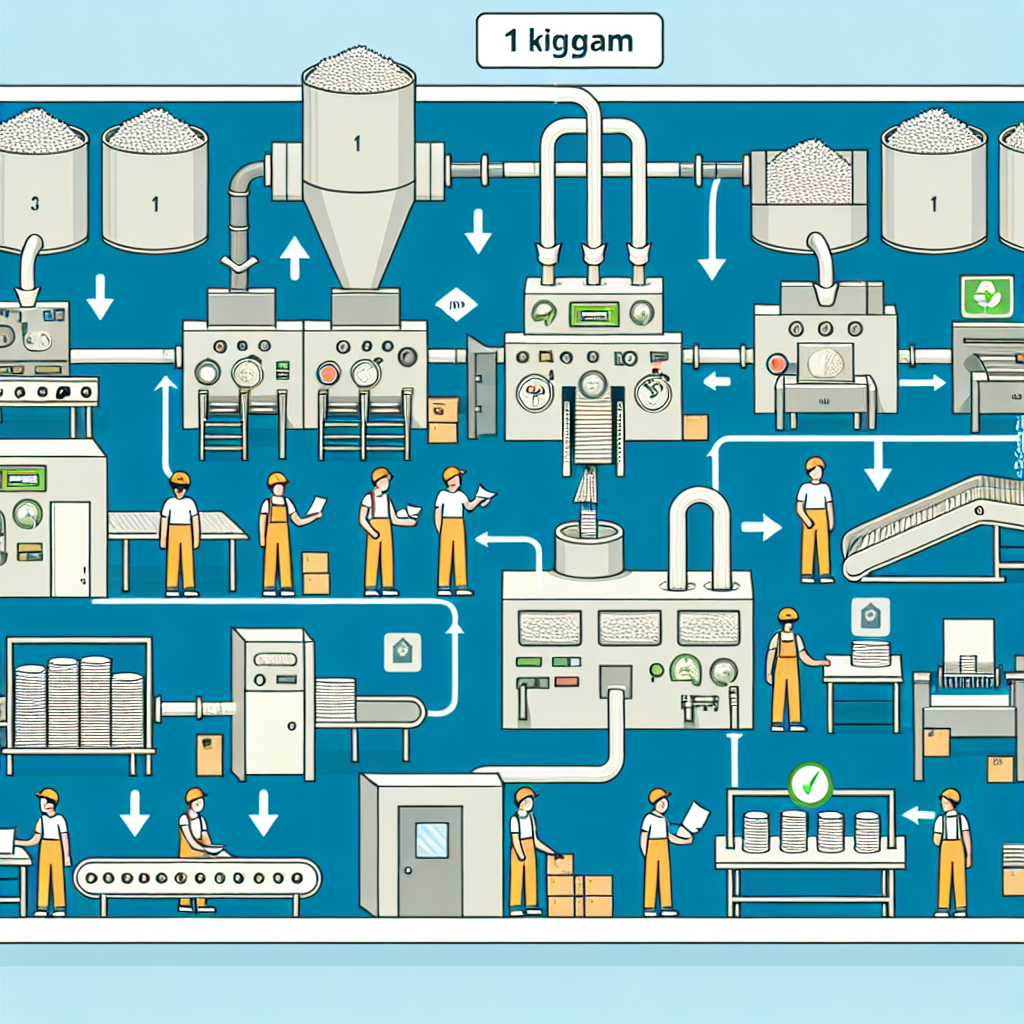Your cart is currently empty!
Discover the secret to maximizing paper plate production to 1 kg and boost your business with this innovative technique.

Image courtesy of via DALL-E 3
Table of Contents
Introduction to Paper Plates
Have you ever wondered about the colorful paper plates we use at parties and picnics? Let’s take a closer look at what paper plates are all about and why they are so important in our lives. We will also explore how these handy plates are made and the fascinating world of paper plate manufacturing.
Boost Production: Maximize Paper Plate Yield Now
Subscribe to our newsletter for exclusive tips and tricks!
So, let’s dive in and uncover the secrets behind the creation of these convenient and cost-effective disposable plates!
What Goes Into Making a Paper Plate?
Have you ever wondered how those handy paper plates you use at parties and picnics are made? Let’s take a closer look at the materials and processes that go into creating these convenient disposable dishes.
Types of Raw Materials
When it comes to making paper plates, the raw materials used are essential. These materials include paper pulp, water, and chemicals. The paper pulp is usually made from wood or recycled paper, which is mixed with water and chemicals to form a thick paste. This paste is then spread out and pressed to create the thin, flat shape of a paper plate.
How Much Raw Material is Needed?
Believe it or not, it only takes about 1 kilogram of raw material to produce a bunch of paper plates. This means that a small amount of material can go a long way in creating these convenient and eco-friendly products. So, the next time you use a paper plate, remember that it only took a little bit of raw material to make it!
Check out how to maximize yield in 1 Kg paper plate production for sustainable growth and profits! [insert link] #manufacturing #sustainability #profitsTweet Quote
How Paper Plates Are Made
In this section, we will delve into the fascinating process of how paper plates are manufactured. Let’s explore the steps involved in creating these convenient and disposable dining essentials.

Image courtesy of www.sciencedirect.com via Google Images
The Production Process
First, paper plates start with raw materials such as paper pulp, water, and sometimes even chemicals to enhance durability. The paper pulp is mixed with water to create a slurry, which is then spread thinly and evenly onto a large rotating drum. As the drum spins, the water is removed, and the pulp begins to dry and take the shape of a plate.
Next, the partially formed plates are transferred to a heated mold that gives them their final shape. The plates are pressed and heated to ensure they are sturdy enough to hold food without collapsing. Once the plates are fully dried and shaped, they are stacked and packaged for distribution.
Making Plates Efficiently
To ensure efficient production, paper plate manufacturers use advanced machinery and automation. This helps them produce a large quantity of plates in a shorter amount of time. By optimizing the production process, they can minimize waste and maximize output, making the production of paper plates cost-effective.
Additionally, manufacturers carefully monitor the production line to identify any potential issues that could lead to defects in the plates. By maintaining high-quality standards and efficiency, they can meet the demands of the market while ensuring that each paper plate meets the necessary safety and quality requirements.
Keeping Costs Down
In the world of paper plate manufacturing, keeping costs down is super important. This helps make sure that paper plates are affordable for everyone to use, whether it’s for a birthday party or a family picnic. Let’s take a closer look at how companies try to save money while making paper plates.
Ways to Save Money Making Paper Plates
One way that paper plate factories save money is by using efficient machines. These machines are super fast and can make a lot of paper plates in a short amount of time. This helps reduce the cost of labor and increases production efficiency.
Another trick that paper plate makers use is to buy raw materials in bulk. By purchasing materials in large quantities, they can get a better price per unit, which helps lower the overall production costs.
Some companies also focus on reducing waste during the manufacturing process. By being careful and precise, they can make sure that they are using every bit of material efficiently, without any unnecessary scraps ending up in the trash.
Overall, by being smart about how they operate and constantly looking for ways to improve their processes, paper plate manufacturers can keep costs down and provide us with affordable and high-quality paper plates for all our needs.
The Big Picture of Paper Plate Business
When we think about paper plates, we often focus on the convenience they bring to our picnics and parties. But have you ever stopped to consider the bigger picture of the paper plate industry? Let’s take a closer look at why paper plates matter and how they fit into the world around us.

Image courtesy of teodoranikova.medium.com via Google Images
Why Paper Plates Matter
Paper plates play a significant role in our daily lives. They provide a simple solution for serving food at gatherings, making cleanup a breeze. Whether it’s a birthday party, a barbecue, or a school event, paper plates make it easy to enjoy delicious meals without the hassle of washing dishes afterwards.
Additionally, paper plates are often made from sustainable materials, making them an eco-friendly choice for those looking to reduce their environmental impact. By using paper plates instead of traditional dishes, we can help minimize water usage and energy consumption associated with washing and drying dishes.
The Future of Paper Plates
As we look ahead, the future of paper plates holds exciting possibilities. Innovations in manufacturing processes and materials may lead to even more sustainable and cost-effective options for paper plate production. Companies in the paper plate industry are constantly working to improve efficiency and reduce waste, ensuring that paper plates remain a practical and environmentally friendly choice for years to come.
Conclusion
Throughout this journey, we have delved into the fascinating world of paper plates, uncovering the secrets behind their production and the materials used. We have learned how paper plate manufacturers efficiently create these essential items while keeping costs down to make them accessible to everyone.
From understanding the types of raw materials required to exploring the production process, we have gained valuable insights into the meticulous work that goes into making paper plates. By uncovering the ways in which paper plate makers work smartly to produce efficiently, we have developed a newfound appreciation for these everyday items.
As we wrap up our exploration, it is clear that paper plates play a significant role in our lives, especially during gatherings, parties, and picnics. Their convenience and practicality make them an indispensable part of our everyday experiences.
Looking ahead, we can only imagine the exciting innovations that the future holds for paper plates. With advancements in technology and sustainability, paper plates are sure to continue evolving to meet the needs of a changing world.
So, the next time you reach for a paper plate, remember the intricate process that goes into creating it and the thoughtful considerations that make it a cost-effective and environmentally friendly choice. Paper plates may seem simple, but they are a testament to human ingenuity and creativity.
Boost Production: Maximize Paper Plate Yield Now
Subscribe to our newsletter for exclusive tips and tricks!
FAQs
What are paper plates made of?
Paper plates are typically made from materials like paperboard, which is a type of thick paper, or molded pulp, which is a mixture of paper and water. These materials are chosen because they are sturdy enough to hold food but also biodegradable, which means they can break down naturally over time.
How much material is needed to make a paper plate?
On average, it takes about 1 kg of raw material to produce a bunch of paper plates. This includes the paper or pulp used to form the plate, as well as any additional materials like coatings or designs. Paper plate manufacturers carefully measure and manage their raw material usage to ensure efficient production.
How are paper plates manufactured efficiently?
Paper plate production efficiency is achieved through streamlined processes and careful planning. Manufacturers use specialized machinery to cut, shape, and mold the raw materials into plates quickly and accurately. By optimizing their production methods, they can create large quantities of paper plates in a cost-effective manner.
What are some ways to save money in paper plate production?
One common method to save money in paper plate production is by utilizing recycled materials. By reusing paper or pulp from other sources, manufacturers can reduce their overall costs. Additionally, optimizing the manufacturing process to minimize waste and increase output efficiency can also contribute to cost savings.
Why are paper plates important in the paper plate industry?
Paper plates play a significant role in the paper plate industry because they are versatile, convenient, and eco-friendly. They are widely used for parties, picnics, and other events where disposable tableware is needed. The demand for paper plates continues to grow, making them a valuable product within the industry.
How do paper plates contribute to sustainability?
Paper plates contribute to sustainability by offering a biodegradable alternative to traditional plastic or foam plates. Because they are made from paper or pulp, they can be easily recycled or composted after use, reducing waste and environmental impact. Choosing paper plates over non-biodegradable options helps promote a more sustainable approach to disposable tableware.

